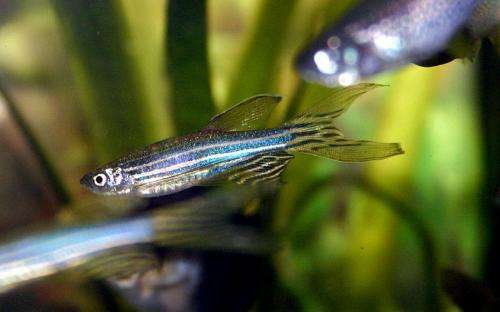The effects of physical sensations on fear behaviors in zebrafish

In humans, massages are used for stress relief and relaxation. Tight wraps called Thundershirts can be used on dogs to reduce anxiety from thunderstorms or separation, and giant rolling brush machines are used in the milk industry to calm and comfort dairy cows. Physical touch can have some beneficial roles, but who knew that fish respond to touch, too?
Researchers at the Duke-NUS Graduate School in Singapore studied the effects of physical sensations on fear behaviors in zebrafish.
Zebrafish become afraid when they smell pheromones released by injured fish, and they respond by freezing in place, darting around quickly, or sinking. Why do the fish respond this way? Researcher Annett Schirmer explains, "species develop a sensitivity to these chemicals throughout the course of evolution such that these chemicals can trigger an automatic response, such as fear."
In other words, by becoming afraid when a nearby fish is injured, the fish can escape or hide from predators more quickly, leading to an increased chance of survival.
Schirmer said that as a kid, her father would claim that his fish enjoyed being petted. "I never believed him," she said. Instead of petting the fish, however, the scientists used moving water as a non-social physical touch. They wanted to see if physical touch could reduce fear responses in fish, similar to how physical touch can comfort humans and other animals.
The zebrafish were exposed to the fear-inducing pheromone and then were either placed in a tank with still water or a tank with a water current for two minutes. The fish exposed to the water current showed fewer fear behaviors and lower levels of cortisol, a stress hormone, than the fish that were placed in the non-moving water. It seemed that the moving water helped to calm and reduce anxiety in the fish.
Fish have a sense of touch for feeling movement and changes in water pressure that comes from cells along the sides of their body called lateral line cells. When fish with damaged lateral line cells were put through the same study, the fish exposed to the water current did not show as large of a decrease in fear behaviors, suggesting that they really are responding to physical sensations from their sense of touch.
Fish swimming in schools feel movement from nearby fish and the current of the water as they are swimming through it. These sensations may reduce fear responses in a similar manner. Schirmer adds, "Current stirs up water and brings nutrients and oxygen. So I think that in the water, touch is a rich emotional stimulus that is, to some degree, also socially relevant."
More information: "Tactile Stimulation Reduces Fear in Fish," Annett Schirmer, Suresh Jesuthasan, and Ajay S. Mathuru. Frontiers in Behavioral Neuroscience. Online Nov. 22, 2013. DOI: 10.3389/fnbeh.2013.00167
Provided by Duke University




















